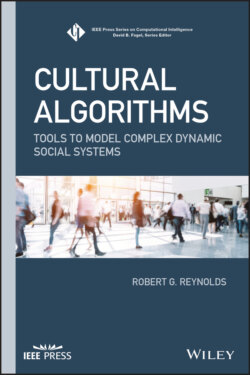Читать книгу Cultural Algorithms - Robert G. Reynolds - Страница 18
Third Law of Thermodynamics, About the Absolute Zero of Temperature
ОглавлениеAs a system asymptotically approaches absolute zero of temperature, all processes virtually cease, and the entropy of the system asymptotically approaches a minimum value.
We metaphorically view our Cultural Algorithm as composed of two systems, a Population of individual agents moving over a performance landscape as well as a collection of knowledge sources in the Belief Space. Each of the knowledge sources can be viewed statistically as a bounding box or generator of control. If we look closely at the second law, it states that over time an individual system will always tend to increase its entropy. Thus, over time the population should randomly spread out over the surface and the bounding box for each knowledge source expand to the edge of the surface, encompassing the entire surface. Yet this does not happen here. This can be seen in terms of a contradiction posed by Maxwell relative to the second law. This Contradiction is the basis for Maxwell's Demon.
In the 1860s, the Physician Maxwell devised a thought experiment to refute the second law [5]. The basis for this refutation was that the human mind was different than pure physical systems and that the universe need not run down as predicted by the second law. In his thought experiment, there were two glass boxes. Within each box was a collection of particles moving at different rates. There was a trap door connecting the boxes controlled by a demon, see Figure 1.2. This demon was able to selectively open the door to “fast” particles from A and allow them to go to B. Therefore, increasing the entropy of B and reducing that of A.
Figure 1.2 An example of Maxwell's demon in action. The demon selectively lets particles of high entropy from one system to another. Reducing the entropy in one and increasing it in the other.
This stimulated much debate among physicists. Leo Szilard in 1929 published a refutation of this by saying that the “Demon” had to process information to make this decision and that processing activity consumed additional energy. He also postulated that the energy requirements for processing the information always exceeded the energy stored through the Demon's sorting.
As a result, when Shannon developed his model of information theory he required all information to be transported along a physical channel. This channel represented the “cost” of transmission specified by Szilard. He was then able to equate the entropy of physical energy with a certain amount of information, called negentropy [6] since it reduced entropy as the Demon does in Figure 1.2.
We can use the metaphor of Maxwell's Demon as a way to interpret the basic problem‐solving process carried out by Cultural Algorithms when successful. We will call this process the Cultural Engine. Recall that the communication protocol for Cultural Algorithms consists of three phases: vote, inherit, and promote (VIP). The voting process is carried out by the acceptance function. The inherit process is carried out by the update function. The promote function is carried out through the influence function. These functions provide the interface between the Population component and the Belief component. Together, similar to Maxwell’s Demon, they extract high entropy individuals first from the population space, update the Belief Space, and then extract high entropy Knowledge Sources from the Belief Space back to modify the Population Space like a two‐stroke thermodynamic engine.
Thus, the evolutionary learning process is viewed to be directed by an engine powered by the knowledge that is learned through the problem‐solving process. While the engine is expressed here in terms of Cultural Algorithm framework, it is postulated that any evolutionary model can be viewed to be powered by a similar type of engine.
